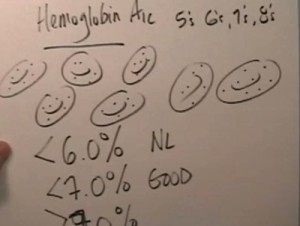What is Hemoglobin A1c ?
Hemoglobin is a type of protein molecule occurring in the red blood cells of the body. Hemoglobin mainly performs the vital function of supplying the oxygen produced by the lungs in the body to the different tissues and organs and in return carry the resultant carbon dioxide back to the lungs for elimination via exhalation.
All of us are aware of the fact that when sugar adheres on a specific surface, then its removal can be very difficult. This same logic is pertinent to the body as well. People with high sugar levels in the body have a tendency to have glycated hemoglobin in the blood.
The excessive sugar levels present in the body result in attachment of the sugar to hemoglobin leading to the development of a layer of sugar on it. Red blood cells normally tend to thrive in the bloodstream for around 120 days. Thus the hemoglobin A1c range test can be used to detect the levels of blood sugar occurring in the body for almost the past 3 months.
A hemoglobin A1c range test is considered as a better and more consistent test as compared to the normal monitoring of glucose conducted at one’s home.
Hemoglobin A1c normal range
- A majority of the hemoglobin A1c tests which are performed to ascertain the normal range differ from laboratory to the other.
- As per the opinion of medical experts, the hemoglobin A1c normal range is generally between 4 and 6 percent. There are other medical views which indicate that diabetic patients should have hemoglobin A1c levels under seven percent.
- A test result which suggests hemoglobin A1c levels to be over 7 percent, points to the fact that the regulation and maintenance of diabetes and blood sugar levels over the last few months have been poor. In these instances, future cases of micro-vascular vulnerabilities and complications can be substantially decreased by getting the hemoglobin A1c level back to the normal mandatory range.
- As the hemoglobin A1c test is used to ascertain the levels of blood sugar, it becomes a very helpful mechanism to avoid the occurrence of certain health complications of the body caused due to affliction with diabetes. A hemoglobin A1c test result that is higher than normal can serve as a warning for patients to engage in lifestyle changes and thus prevent the accompanying diseases and disorders like ocular problems, kidney disorders, cardiac abnormalities, stroke and nerve damage.
- A hemoglobin A1c test result that is lower than normal often points to a recent or latest case of hypoglycemia. Low hemoglobin A1c test results are also serious as low levels of blood sugar can lead to deaths.
- One can safely conclude that the hemoglobin A1c test is thus one of the best ways to ascertain the levels of blood sugar in the body.

Hemoglobin A1c chart and the blood sugar levels
The hemoglobin A1c test examines the red blood cells to check for the presence of sugar deposits on them, for over a duration of 120 days. This allows the doctors to gauge whether the patients have been controlling the blood sugar levels and also taking care of their body over the last few weeks or months. The existence of a close correlation between the blood sugar levels and the level of hemoglobin A1c, helps physicians to recommend a number of steps and changes in lifestyle that can allow the patient to easily control both of them.
The chart provided below is an estimated calculation of the correlation between the blood sugar levels and levels of hemoglobin A1c. The term “mg/dL” refers to milligrams per deciliter of blood.
| HbA1c (%) | Average Blood Sugar (mg/dL) |
| 5 | 80 |
| 6 | 120 |
| 7 | 150 |
| 8 | 180 |
| 9 | 210 |
| 10 | 240 |
| 11 | 270 |
| 12 | 300 |
| 13 | 333 |
| 14 | 360 |
Hemoglobin A1c Test
During the hemoglobin A1c test, a blood sample is collected from a vein in the arm, which is then examined at a laboratory to ascertain the hemoglobin A1c levels. If the patient is diagnosed with diabetes, then the doctor may recommend regular hemoglobin A1c tests at intervals of 3 to 6 month, which in turn is dependent on the type of diabetes afflicting the patient
It is important to note that individuals with preexisting medical abnormalities such as kidney disorders, liver problems and anemia, or those who have experience heavy loss of blood, may yield influenced hemoglobin A1c test results that give false numbers. Additionally, the hemoglobin A1c test can pose other risks like infection, collection of blood beneath the skin, disorientation or fainting, etc, due to the drawing of blood from the arm vein.
As discussed earlier, different laboratories may provide varied hemoglobin A1c test results and therefore individuals must consult a doctor to verify such reports for meaning and content.
However, it is firmly believed that despite the few shortcomings, the hemoglobin A1c test is one of the best methods to check, control and monitor the levels of blood sugar in the body. It particularly holds true for diabetic patients, who can engage in regular checkups to control blood sugar levels, and make the relevant diet and lifestyle changes to continue living a normal life.

Do you have any {recommendationshintstips and
I got this web site from my friend who told me on the
topic of this website and at the moment this time I am browsing
this website and reading very informative articles or reviews here.